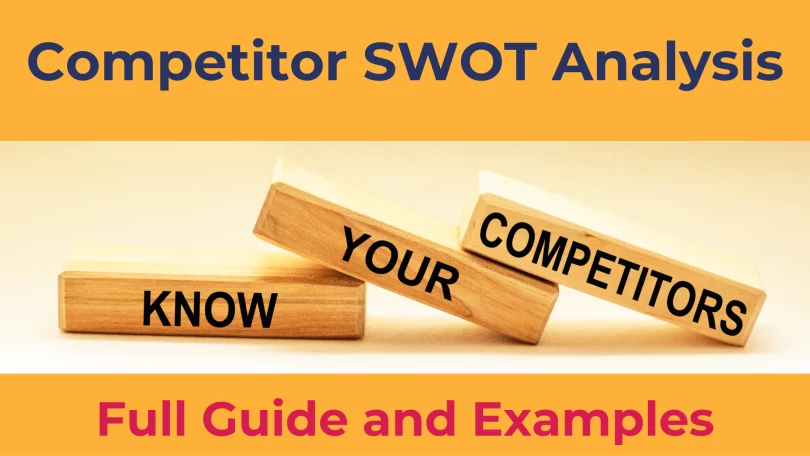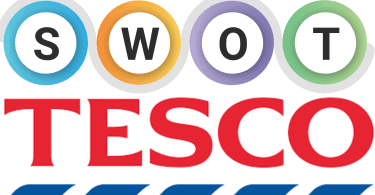In the battlefield of industries, the most potent weapon isn’t always a superior product.
It’s the exhaustive knowledge of your competitors. Enter the realm of competitor SWOT analysis, a strategic blueprint for businesses aiming to secure their competitive edge.
Regularly analyzing rivals’ strengths, weaknesses, opportunities, and threats isn’t just a tactic, it’s a mindset that fosters adaptability and growth.
In this detailed article, you will discover the définition of a competitor SWOT analysis, its importance for any business, and real-life examples and templates.
What is a competitor SWOT analysis?
A competitor SWOT analysis is a strategic planning tool that helps businesses identify and evaluate their competitors’ strengths, weaknesses, opportunities, and threats.
By understanding their competitors’ internal and external factors, your company can gain a competitive advantage and make informed decisions about its strategies.
Strengths are internal factors that give a business an advantage over its competitors. These can include factors such as:
- Strong brand recognition and reputation
- Innovative products or services with unique features
- Loyal customer base and high customer satisfaction
- Efficient operations, cost advantages, and strong financial position
- Talented workforce with expertise and experience.
Weaknesses are internal factors that put a business at a disadvantage. These can include factors such as:
- Weak brand recognition or negative reputation
- Lack of innovation or outdated products/services
- High customer churn rate or low customer satisfaction
- Inefficient operations, high costs, or vulnerable financial position
- Lack of talent or skills gaps in the workforce.
Opportunities are external factors that businesses can exploit to gain an advantage. These can include factors such as:
- Growing market demand or emerging market trends
- Technological advancements that can enhance their products/services
- Favorable government policies or regulatory changes
- Expanding into new geographic markets or customer segments
- Partnerships or acquisitions that can strengthen their competitive position.
Threats are external factors that can harm a business’s competitive position. These can include factors such as:
- New competitors entering the market with disruptive products/services
- Economic downturns or recessions that impact consumer spending
- Changes in consumer preferences or buying behaviors
- Unfavorable government regulations or policy changes
- Technological disruptions that make their products/services obsolete.
Should you do a swot analysis on competitors?
Doing a SWOT analysis on your competitors is very helpful for many reasons. Here are a few of the most important reasons:
- To understand your competitors’ strengths and weaknesses. This can help you to identify areas where your business is at a disadvantage and where you can improve.
- To identify opportunities to exploit your competitors’ weaknesses. For example, if your competitor has a weak brand reputation, you can focus on building a stronger brand for your own business.
- To anticipate threats from your competitors. For example, if your competitor is planning to launch a new product, you can start to develop your strategy for responding to this threat.
- To make informed decisions about your business strategy. By understanding your competitors, you can better allocate your resources, determine what products or services to offer, and determine how to market your business.
- To stay ahead of the competition. The business world is constantly changing, and staying current on your competitors’ activities is crucial. A SWOT analysis can help you identify new trends and challenges you may need to address.
In short, a SWOT analysis is a valuable tool for understanding your competitors and making informed decisions about your business. I recommend starting today if you are not already doing a SWOT analysis on your competitors.
Overall, a SWOT analysis is a valuable tool for any business that wants to stay competitive and succeed in the marketplace.
How to perform a competitor SWOT analysis?
Conducting a competitor SWOT analysis involves a structured approach to gathering and analyzing information about your competitors’ strengths, weaknesses, opportunities, and threats.
Here’s a step-by-step guide to performing a competitor SWOT analysis:
Step 1: Identify Your Key Competitors
Start by defining your target market and identifying the direct competitors that operate in the same space. Consider product or service offerings, target audience, and geographic reach.
Step 2: Gather Information about Your Competitors
Collect data from various sources, including:
- Company websites: Review their products, services, pricing, customer reviews, and financial statements.
- Industry reports: Analyze market trends, competitor performance, and industry forecasts.
- Social media: Monitor their interactions with customers, identify brand sentiment, and track their marketing campaigns.
- News articles: Keep up with their latest developments, announcements, and press releases.
- Customer reviews: Understand customer satisfaction levels, identify areas for improvement, and gauge their competitive advantages.
Step 3: Analyze the Information
Organize the gathered information into a SWOT matrix with four quadrants: strengths, weaknesses, opportunities, and threats.
Strengths: Identify internal factors that give your competitors an edge.
Weaknesses: Identify internal factors that put your competitors at a disadvantage.
Opportunities: Identify external factors that your business and your competitors can exploit to their advantage.
Threats: Identify external factors that pose challenges to your company and your competitors.
Step 4: Draw Conclusions about Your Competitors’ Competitive Position
Summarize your findings and evaluate your competitors’ overall competitive strengths and weaknesses. Identify areas where they excel and areas where they are vulnerable.
Step 5: Develop Strategies to Capitalize on Your Competitors’ Weaknesses and Exploit Their Opportunities
Use your insights to develop strategies that leverage your strengths and exploit your competitors’ weaknesses. Position your offerings to address their shortcomings and capitalize on emerging market opportunities.
Step 6: Monitor Your Competitors’ Activities on an Ongoing Basis
Gather and analyze information about your competitors’ activities, as their strengths, weaknesses, opportunities, and threats can change over time. Regularly update your competitor’s SWOT analysis to remain accurate and relevant.
Competitor SWOT analysis example
Netflix faces stiff competition from several streaming services, each with unique strengths and weaknesses. Let’s say you’re in top management at Netflix and want to do a competitor swot analysis.
The first step is to get to know your competitors. Here are some of Netflix’s key competitors:
- Disney+: Disney+, launched in 2019, is home to a vast library of content from Disney, Pixar, Marvel, Star Wars, and National Geographic. It also offers exclusive original series and movies, making it a strong contender in the streaming market.
- Amazon Prime Video: Amazon Prime Video is a popular streaming service included with an Amazon Prime membership. It offers diverse content, including original series, movies, TV shows, and documentaries.
- HBO Max: HBO Max is the streaming home of HBO, known for its critically acclaimed original programming. It also includes content from Warner Bros., DC Comics, Cartoon Network, and more.
- Hulu is a joint venture between Disney, Comcast, and WarnerMedia. It offers a mix of live TV, original programming, and library content, including popular TV shows from ABC, FOX, and NBC.
- Apple TV+: Apple TV+ is Apple’s streaming service, offering original series, movies, and documentaries. It has garnered critical acclaim for its high-quality productions.
- YouTube TV: YouTube TV is a live TV streaming service that offers a variety of channels, including local networks, sports channels, and cable channels.
- Peacock: Peacock is NBCUniversal’s streaming service, offering a mix of live TV, original programming, and library content, including classic TV shows and movies.
- Paramount+: Paramount+ is the streaming home of Paramount Pictures, CBS, MTV, Nickelodeon, and Comedy Central. It offers a mix of original programming, library content, and live TV.
- Fubo TV: Fubo TV is a live TV streaming service focused on sports, offering various sports channels.
- Sling TV: Sling TV is another live TV streaming service offering a variety of channel packages, including sports, news, and entertainment channels.
We therefore decided to perform a SWOT analysis of Disney+. Here are the main results:
Strengths:
- Strong brand recognition: Disney+ benefits from the strength of the Disney brand, which is one of the world’s most recognizable and respected brands. This brand recognition gives Disney+ a significant advantage in attracting new subscribers.
- A vast library of content: Disney+ has access to an extensive library of content from Disney, Pixar, Marvel, Star Wars, and National Geographic. This includes iconic films, popular TV shows, and beloved characters that appeal to a broad audience.
- Exclusive original content: Disney+ has invested heavily in original content, including new series, movies, and documentaries. This original content has been well-received by critics and viewers, helping to differentiate Disney+ from its competitors.
- Global reach: Disney+ is available in over 200 countries and territories, giving it a global reach that few other streaming services can match. This global reach is essential for Disney’s growth strategy.
- Bundled with other Disney services: Disney+ is often bundled with other Disney services, such as ESPN+ and Hulu. This bundling makes Disney+ more attractive to consumers and can help to increase subscriber numbers.
Weaknesses:
- Limited content diversity: While Disney+ has a vast library of content, it lacks the diversity of some of its competitors, such as Netflix and Amazon Prime Video. This could limit Disney+’s appeal to some viewers.
- Reliance on family-friendly content: Disney+ is known for its family-friendly content, which may not appeal to all viewers. This could limit Disney+’s ability to attract older viewers or viewers with more mature tastes.
- Consumer price sensitivity: Disney+ is one of the most expensive streaming services on the market. This price sensitivity could limit Disney+’s ability to attract new subscribers, particularly in price-sensitive markets.
- Relying on existing franchises: Disney+ has relied heavily on its existing franchises, such as Star Wars and Marvel, for its original content. This could limit Disney+’s ability to create new and innovative content.
Opportunities:
- Expanding into new markets: Disney+ can expand into new markets, such as India and China. These markets have a large potential audience for streaming services.
- Developing new technologies: Disney+ can continue investing in new technologies, such as augmented reality and virtual reality, to enhance its offerings and create new experiences for viewers.
- Partnerships with other companies: Disney+ can partner with other companies, such as telecommunications companies or retail partners, to expand its reach and attract new subscribers.
- Merchandising and licensing opportunities: Disney+ can leverage its vast content library to generate revenue through merchandising and licensing deals.
- Growing demand for streaming content: The demand for streaming content is growing rapidly, driven by increasing internet penetration and changing consumer preferences. This trend could benefit Disney+ in the long term.
Threats:
- Increased competition: The streaming market is becoming increasingly crowded, with new services constantly launching. This increased competition could make it more difficult for Disney+ to maintain its market share.
- Changing consumer preferences: Consumer preferences are constantly evolving, and Disney+ needs to stay ahead of trends to maintain its relevance.
- Economic downturns: Economic downturns could impact consumer spending and reduce demand for subscription services like Disney+.
- Changes in copyright laws: Changes in copyright laws could make it more difficult for Disney+ to acquire and retain content.
- Technological disruptions: Technological disruptions, such as the rise of new streaming platforms or content formats, could challenge Disney+’s business model.
Disney+ is a robust streaming service with a vast library of content, a global reach, and the backing of a powerful brand. However, it faces challenges from increased competition, changing consumer preferences, and economic downturns.
Here are the areas where Disney+ excels and is vulnerable compared to Netflix:
| Areas | Disney+ | Netflix |
|---|---|---|
| Brand recognition | Strong | Strong |
| A vast library of content | Yes | Yes |
| Exclusive original content | Yes | Yes |
| Global reach | Yes | Yes |
| Bundled with other services | Yes | Yes |
| Content diversity | Limited | Diverse |
| Reliance on family-friendly content | Yes | No |
| Price sensitivity of consumers | Vulnerable | Vulnerable |
| Relying on existing franchises | Yes | No |
| Competition from other streaming services | Yes | Yes |
| Innovation | Less innovative | More Innovative |
| Overall competitive strengths | Strong brand, vast library of content, global reach | Diverse content, innovation |
| Overall competitive weaknesses | Limited content diversity, reliance on family-friendly content, price sensitivity, reliance on existing franchises | Increasing competition, production bottlenecks, reliance on licensed content |
Overall, Disney+ and Netflix are both well-positioned streaming services with a number of competitive strengths. However, they each face different challenges.
Netflix needs to find ways to reduce its reliance on licensed content and continue to produce high-quality original and family-friendly content.
To capitalize on Disney+’s weaknesses and exploit its opportunities, Netflix should implement the following strategies:
- Expand its content diversity: Netflix should continue to invest in acquiring and producing a wide range of content to appeal to a broader audience. This includes diversifying its library of TV shows, movies, documentaries, and other forms of content.
- Target older viewers and viewers with more mature tastes: Netflix should create original content that appeals to older viewers and viewers with more mature tastes. This could include dramas, comedies, and more complex and thought-provoking thrillers.
- Offer a more affordable pricing tier: Netflix should consider offering a more affordable pricing tier to attract price-sensitive consumers. This could be a limited-ad tier or a tier with a smaller content selection.
- Reduce reliance on licensed content: Netflix should reduce its reliance on licensed content and invest more heavily in producing its original content. This will give Netflix more control over its content library and make it less vulnerable to changes in licensing agreements.
- Invest in new technologies: Netflix should continue to invest in new technologies, such as artificial intelligence and virtual reality, to enhance its streaming experience. This could include personalized recommendations, interactive content, and immersive virtual experiences.
- Expand into new markets: Netflix should continue to expand into new markets, such as India and China. These markets have a large potential audience for streaming services.
- Develop partnerships with other companies: Netflix should partner with other companies, such as telecommunications companies or retail partners, to expand its reach and attract new subscribers.
- Merchandising and licensing opportunities: Netflix should leverage its vast content library to generate revenue through merchandising and licensing deals. This could include partnerships with toy companies, apparel brands, and other businesses.
- Focus on innovation: Netflix should continue to be a leader in innovation, constantly seeking new ways to improve its streaming service. This could include developing new features, improving its recommendation engine, and creating new forms of interactive content.
- Adapt to changing consumer preferences: Netflix should stay ahead of the curve by adapting to changing consumer preferences. This could involve investing in new content genres, developing new viewing experiences, and adjusting pricing and marketing strategies.
By implementing these strategies, Netflix can capitalize on Disney+’s weaknesses, exploit its opportunities, and solidify its position as a leading streaming service.
Market research and competitor SWOT analysis
Market research and competitor SWOT analysis are complementary processes that help businesses understand their industry, competitors, and target market.
Market research is gathering and analyzing information about a market, including its size, growth rate, trends, and key players. This information can be used to identify new opportunities, develop new products or services, and improve marketing strategies.
In practice, businesses often use both market research and competitor SWOT analysis to inform their strategic decision-making. Market research can provide the context for competitor SWOT analysis, and competitor SWOT analysis can help businesses identify specific areas where they need to conduct further market research.
Here are some examples of how businesses can use market research and competitor SWOT analysis together:
- A new restaurant might conduct market research to understand diners’ preferences in its area and then use competitor SWOT analysis to identify opportunities to differentiate its menu and service from its competitors.
- A software company might conduct market research to understand the needs of businesses in its target industry and then use competitor SWOT analysis to identify opportunities to develop new features or products that will give it a competitive advantage.
- An e-commerce retailer might conduct market research to understand consumers’ online shopping habits in its target market and then use competitor SWOT analysis to identify opportunities to improve its website and marketing campaigns.
By combining market research and competitor SWOT analysis, businesses can gain a comprehensive understanding of their industry, their competitors, and their target market, which can help them make informed strategic decisions and achieve their business goals.
Conclusion
Competitor SWOT analysis is a valuable tool for businesses of all sizes. By understanding their competitors, businesses can make informed decisions about their strategies and gain a competitive advantage.
Furthermore, continual success in the competitive arena hinges on more than just initial analysis—it thrives on perpetual evolution.
The landscape of business is dynamic, and so are your competitors. Hence, the true power of competitor SWOT analysis lies in its inception and ongoing updates.
Remember, staying ahead demands agility and adaptability. By consistently refreshing your understanding of competitors’ strengths, weaknesses, opportunities, and threats, you equip your business with the foresight needed to pivot, innovate, and maintain a competitive edge.
SWOT Analysis Examples 2024
There is no better way to understand how to conduct a SWOT analysis at your company than with a concrete example.
Below you will find our free, up-to-date, and concrete examples of SWOT analyses of large companies and multinationals conducted in 2024.












Leave a Comment